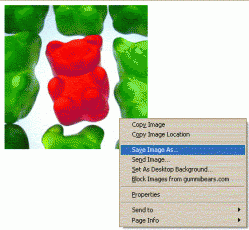Why this might be a good and worthy thing to do:
Looking at a pile of unclaimed print-outs from our Library color printer - most having a tiny picture tucked away in one corner - one imagines the tortured death-screams of trees. This could be traumatic.
Why this practice might be somewhat ill-advised:
Someday, when the students are in 8th grade, their Social Studies teacher will tell them to retrieve their pictures to insert into a blog or some other document. Most of the students will not be able to find their pictures. When the long-suffering Social Studies teacher asks them where they stored their pictures, they will say, "I dunno - in a Word file, somewhere..."
At which point, the teacher will die of a stroke, leaking blood from his ears and grinning in a horrible rictus of death, which might be even more traumatic to some of the students than the killing-trees-thing.
A less sarcastic explanation of why this practice might be somewhat ill-advised:
1. Unless you are planning to print out pictures and physically glue them onto a poster, placing them into a word-processing document doesn't do you a lot of good. If you need to insert them into a slide show, or into a blog, or email them to somebody, it is very difficult to access them in a document.
2. Not surprisingly, word-processing programs are designed to process... well.. um, words. They can hold onto images (sort of), but that's not what they are designed to do and they don't won't treat your images very gently. Pictures go in nice and sharp and come out somewhat scuzzier.
A much better way to save images is as image files - usually .jpg or .gif files.
"Okay, JargonBoy - what the heck is a 'jay-peg'?"
Here's the way I explain it to my students:
If you found a file called vocals.mp3, could you guess what kind of file it was?
Music, right?
How did you know?
From the file extension - the three letters after the "dot". At this point, you know that ".mp3" means a sound file. You've probably also noticed that word processing files have ".doc" or something similar at the end of their file names. That's all we're talking about. Although there are many different file extensions for pictures, most of the time, a given picture file will be either a .jpg or a .gif file.
"Yeah, yeah... Fine... Whatever... How do I save one of these JiffyPop things?"
.jpeg.
Or .gif.
Okay - go find a picture online that you like and right-click it.

Choose "Save Image As..."
Then you just choose where you want to save the file, then save it.
Then, when some crazed-looking middle-school teacher wants to see your .jpg, you'll know it probably isn't as creepy as you think.
 RSS Feed
RSS Feed